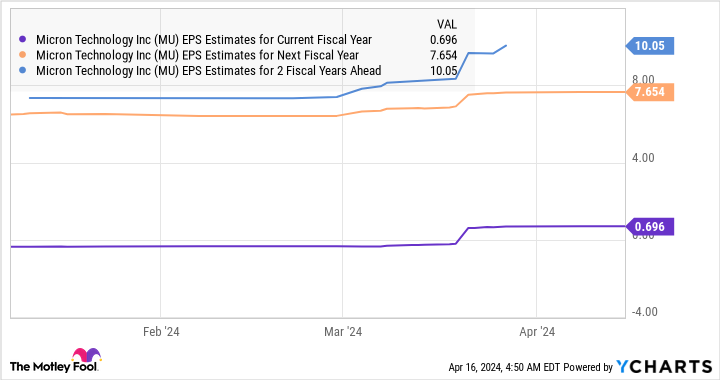2 Top Artificial Intelligence (AI) Stocks to Buy in April

These AI stocks trade at attractive valuations, and they could take off impressively over the long run.
Many of the companies benefiting from the rapid adoption of artificial intelligence (AI) have seen their share prices rise impressively since the beginning of 2022, making it difficult for investors to find worthy AI stocks trading at reasonable or relatively attractive valuations.
Difficult, but not impossible.
There are at least two solid opportunities right now for investors looking to get their hands on potential AI winners that haven’t become prohibitively expensive from a valuation standpoint — Micron Technology (MU -3.78%) and Oracle (ORCL -2.25%). Let’s find out a bit more about these two AI stocks and why they might make good additions to your investment portfolio in April.
1. Micron Technology
Micron Technology stock’s year-to-date gains stand at 42%, which explains why it is now trading at 7.3 times sales as compared to 5.8 times sales at the end of 2023. However, Micron’s sales multiple is in line with the U.S. technology sector’s average price-to-sales ratio of 7.1. It is also worth noting that Micron’s forward price-to-earnings ratio has plunged to a much lower level than the tech sector’s average of 44.3 thanks to the company’s recent growth acceleration.
MU PE Ratio (Forward 1y) data by YCharts.
So, investors can still buy Micron at a reasonable valuation. They should consider capitalizing on this opportunity, as the chipmaker could grow at a faster-than-expected pace because of favorable memory pricing trends. Taiwanese publication DigiTimes expects Micron to raise the prices of its dynamic random-access memory (DRAM) and NAND flash memory by more than 25% in the second quarter. And DRAM prices already rose by 10% to 15% in the first quarter.
The stronger memory pricing environment is the result of a spike in demand, mainly due to a combination of the growth in AI use and memory manufacturers’ strategy of keeping their output in check. For instance, Micron management pointed out on its March earnings conference call that it expects its spending on wafer and fabrication equipment to drop in its fiscal 2024 (which began Sept. 1).
Moreover, memory manufacturers’ output was impacted by the recent earthquake in Taiwan, and reports indicate that they are weighing further price hikes to make up for any production shortfalls. Throw in the fact that semiconductor companies such as Nvidia, Intel, and Advanced Micro Devices have been looking to get their hands on more high-bandwidth memory (HBM) to make more powerful AI chips, the demand for Micron’s offerings should continue to remain hot.
As it turns out, HBM prices shot up by a whopping 500% last year. The trend is expected to continue in 2024 with the HBM market’s revenue expected to jump by at least 150% to more than $14 billion, according to Yole Group. Not surprisingly, analysts have been raising Micron’s earnings per share (EPS) predictions based on recent developments.
MU EPS Estimates for Current Fiscal Year data by YCharts.
If the stock does hit the consensus EPS forecast of $10.05 in a couple of fiscal years, and if at the point it trades at 27 times forward earnings, in line with the Nasdaq-100‘s forward earnings multiple (using the index as a proxy for tech stocks), its stock price would have more than doubled to $270 per share. That’s a solid argument for buying Micron stock this month.
2. Oracle
Oracle’s AI credentials got a big boost after the company released its fiscal 2024 third-quarter results last month. Investors bought the stock hand over fist following the report, which offered clear evidence that AI is set to drive significant growth in the business.
Shares of Oracle are up almost 15% this year, and the good part is that the stock is currently trading at 32 times trailing earnings. Its forward earnings multiple of 19 is even more attractive. It would be a good idea to buy Oracle at this valuation considering the potential for accelerating earnings growth.
Analysts forecast that its bottom line will grow at an annualized rate of 11% for the next five years, up from 9% in the past five. However, the company’s improving revenue pipeline indicates that it could outpace analysts’ expectations. Oracle’s remaining performance obligations (RPO) rose by 29% year over year to $80 billion last quarter. RPO is the total value of future contracts that a company has to fulfill, and Oracle’s increased at a faster rate than its 7% increase in quarterly revenue to $13.3 billion.
Even better, Oracle’s RPO is significantly higher than its trailing-12-month revenue of $52.5 billion. AI is playing a central role in boosting its revenue pipeline. Management pointed out that the significant jump in RPO was driven by the “large new cloud infrastructure contracts” that it signed during the quarter.
More importantly, the company believes that it will continue to win more new business “because the demand for our Gen2 AI infrastructure substantially exceeds supply.” Also, it expects its cloud infrastructure business to “remain in a hypergrowth phase” thanks to its aggressive efforts to build new data centers and expand its existing ones to meet AI-related demand.
It is worth noting that the demand for cloud-based AI services is forecast to increase at a stunning annualized rate of close to 40% through the end of the decade. Oracle has started capitalizing on this opportunity already and seems set to deliver robust growth in the long run. In light of all that, buying shares of Oracle right now could turn out to be a smart long-term move.
Harsh Chauhan has no position in any of the stocks mentioned. The Motley Fool has positions in and recommends Advanced Micro Devices, Nvidia, and Oracle. The Motley Fool recommends Intel and recommends the following options: long January 2025 $45 calls on Intel and short May 2024 $47 calls on Intel. The Motley Fool has a disclosure policy.



